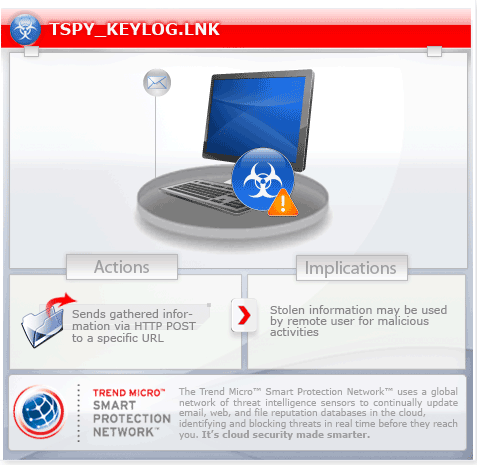TSPY_KEYLOG.LNK
Windows 2000, Windows Server 2003, Windows XP (32-bit, 64-bit), Windows Vista (32-bit, 64-bit), Windows 7 (32-bit, 64-bit)


Threat Type: Spyware
Destructiveness: No
Encrypted: Yes
In the wild: Yes
OVERVIEW
Spammed via email
This is a keylogger found inside a spammed email message that purports to come from the Cabinet Office Information Systems Office.
To get a one-glance comprehensive view of the behavior of this Spyware, refer to the Threat Diagram shown below.

This spyware arrives as an attachment to email messages spammed by other malware/grayware or malicious users.
It logs a user's keystrokes to steal information.
It deletes the initially executed copy of itself.
TECHNICAL DETAILS
234,328 bytes
EXE
Yes
24 Jan 2012
Arrival Details
This spyware arrives as an attachment to email messages spammed by other malware/grayware or malicious users.
Installation
This spyware drops the following files:
- {All Users Profile}\Microsoft\PDA\Mircosoft System..DLL
It creates the following folders:
- {All Users Profile}\Microsoft\PDA
Autostart Technique
This spyware registers itself as a system service to ensure its automatic execution at every system startup by adding the following registry entries:
HKEY_LOCAL_MACHINE\SYSTEM\CurrentControlSet\
Services\Mircosoft System.
Type = 10
HKEY_LOCAL_MACHINE\SYSTEM\CurrentControlSet\
Services\Mircosoft System.
Start = 2
HKEY_LOCAL_MACHINE\SYSTEM\CurrentControlSet\
Services\Mircosoft System.
ErrorControl = 1
HKEY_LOCAL_MACHINE\SYSTEM\CurrentControlSet\
Services\Mircosoft System.
ImagePath = %System%\svchost.exe -k LocalService
HKEY_LOCAL_MACHINE\SYSTEM\CurrentControlSet\
Services\Mircosoft System.
DisplayName = "Mircosoft System."
HKEY_LOCAL_MACHINE\SYSTEM\CurrentControlSet\
Services\Mircosoft System.
ObjectName = "LocalSystem"
HKEY_LOCAL_MACHINE\SYSTEM\CurrentControlSet\
Services\Mircosoft System.
Description = "Mircosoft System."
HKEY_LOCAL_MACHINE\SYSTEM\CurrentControlSet\
Services\Mircosoft System.\Parameters
ServiceDll = {All Users Profile}\Microsoft\PDA\Mircosoft System..DLL
Other System Modifications
This spyware modifies the following registry key(s)/entry(ies) as part of its installation routine:
HKEY_LOCAL_MACHINE\SOFTWARE\Microsoft\
Windows NT\CurrentVersion\SvcHost
LocalService = {Default Value} Mircosoft System.
(Note: The default value data of the said registry entry is {Default Value}.)
It adds the following registry keys as part of its installation routine:
HKEY_CLASSES_ROOT\SS
Information Theft
This spyware logs a user's keystrokes to steal information.
Stolen Information
This spyware saves the stolen information in the following file:
- %System%\intel.dat
(Note: %System% is the Windows system folder, which is usually C:\Windows\System32.)
It sends the gathered information via HTTP POST to the following URL:
- {BLOCKED}.{BLOCKED}.60.142
Other Details
This spyware deletes the initially executed copy of itself
SOLUTION
9.300
9.679.00
24 Jan 2013
Step 1
Before doing any scans, Windows XP, Windows Vista, and Windows 7 users must disable System Restore to allow full scanning of their computers.
Step 2
Restart in Safe Mode
Step 3
Delete this registry key
Important: Editing the Windows Registry incorrectly can lead to irreversible system malfunction. Please do this step only if you know how or you can ask assistance from your system administrator. Else, check this Microsoft article first before modifying your computer's registry.
- In HKEY_LOCAL_MACHINE\SYSTEM\CurrentControlSet\Services
- Mircosoft System.
- Mircosoft System.
- In HKEY_CLASSES_ROOT
- SS
- SS
Step 4
Restore these modified registry values
Important:Editing the Windows Registry incorrectly can lead to irreversible system malfunction. Please do this only if you know how to or you can seek your system administrator's help. You may also check out this Microsoft article first before modifying your computer's registry.
- In HKEY_LOCAL_MACHINE\SOFTWARE\Microsoft\Windows NT\CurrentVersion\SvcHost
- From: LocalService = {Default Value} Mircosoft System.
To: LocalService = {Default Value}
- From: LocalService = {Default Value} Mircosoft System.
Step 5
Search and delete this folder
- {All Users Profile}\Microsoft\PDA
Step 6
Search and delete these files
- %System%\intel.dat
- %AppDataLocal%\VirtualStore\Windows\System32\intel.dat
Step 7
Restart in normal mode and scan your computer with your Trend Micro product for files detected as TSPY_KEYLOG.LNK. If the detected files have already been cleaned, deleted, or quarantined by your Trend Micro product, no further step is required. You may opt to simply delete the quarantined files. Please check this Knowledge Base page for more information.
Did this description help? Tell us how we did.

